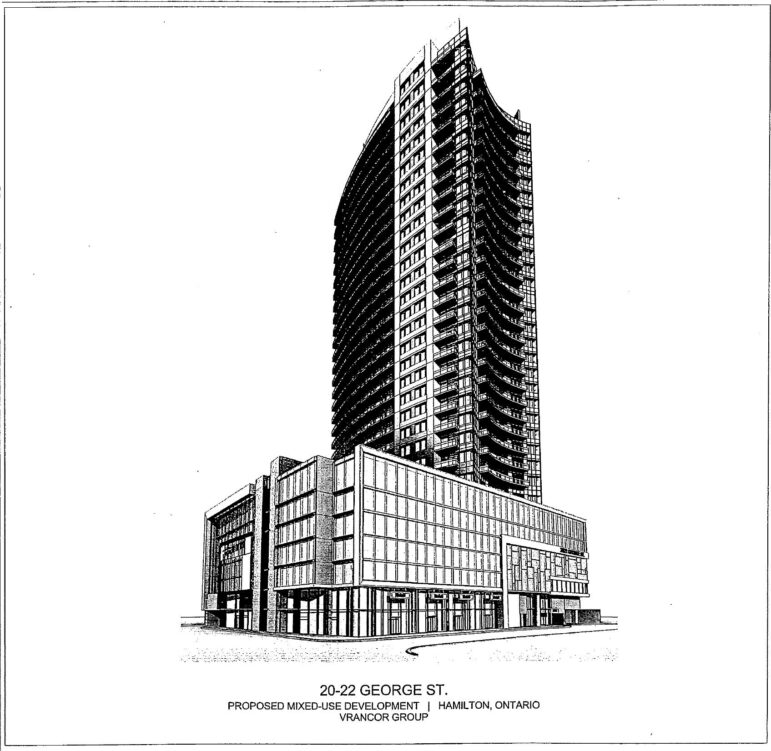Hamilton’s broken planning approval process is now seeing Hamilton’s Committee of Adjustment approve new tall buildings as “minor variances”, skipping public Planning Committee hearings, public release of staff report comments, and clearly breaking the intent of minor variances in the Planning Act.
It was never intended that “minor variances” would be used to approval major tall building developments.
When I first deliberated the use of the word “major” in the context of Committee of Adjustment, it was related to variances for small units in true affordable housing – the Indwell development on Melvin Avenue at Parkdale – which sought 24 square metre units in place of the required minimum 65 square metres.
In this instance, my initial thought was that a variance of 60% was potentially major. However, the variance would recognize the existing room sizes under the previous lodging zoning.
Since that time, things have changed. We now have actual major changes being pushed as “minor variances”. Ward 2 Councillor Jason Farr is using the Committee of Adjustment to bypass proper planning process and public consultations to approve tall buildings as “minor variances”, more on that later in the post.
First, the purpose of Committee of Adjustment and the definition – or lack of a clarity – of what is a minor variance.
What is a Minor Variance?
Committee of Adjustment is a quasi-judicial body which is empowered to grant exceptions (“variances”) to municipal zoning regulations under Section 45 of the Planning Act.
The intent of having Committee of Adjustment is to allow municipalities to pass clear zoning bylaws, and for consideration of individual circumstances where relief is needed.
The Planning Act sets a four part test:
- Is the application minor?
- Is the application desirable for the appropriate development of the lands in question?
- Does the application conform to the general intent of the Zoning By-law?
- Does the application conform to the general intent of the Official Plan? It is important to note that to consider any application a minor variance it must meet all four tests.
What is minor you ask? Whatever the Committee deems it to be.
Some municipalities have clear policies stating that “minor variances” are not to be used to bypass full planning processes.
Mississauga states “The minor variance application process is a method to seek relief through a Committee of Adjustment when hardship or circumstances do not allow you to meet the standards listed in the by-law”.
Does Minor/Major/Significant in CoA = Guilty/Not Guilty in Legal Coverage?
In coverage of criminal cases, journalists in non-opinion coverage do not use the words “guilty” or “not guilty” to describe a case. Even in opinion columns, the use of “guilty” or “not guilty” is frowned upon and rare.
This is seen as prejudicial to the process.
The stakes in a minor variance applications are much lower, a person’s liberty is not at stake. For applicants, the stakes are higher – many variances are sought by individuals seeks to build their dream be it a garden, patio, or even their house. To each applicant, their file is important.
Would calling an application major in my journalism prejudice the proceedings? Would it result in more community reaction to an application to call it major – such as in the Indwell case cited near the beginning of this post. Many nearby residents were initially opposed on the grounds it was major, until it was clarified the variance was solely to recognize an existing condition.
The Committee of Adjustment is not a jury, in that they are not selected from a random pool of applicants. Individuals apply to the committee, and in the case of Hamilton, generally have a real estate or planning background.
The Committee members are not easily, if at all, influenced by media.
There is no overriding reason for avoiding the term major in the context of describing applications, if major is reflective of the applications.
Tall Buildings as Minor Variances
I volunteer with my neighbourhood association, the Beasley Neighbourhood Association, as our Committee of Adjustment coordinator. It was a great fit, I’m at City Hall anyway, and it was extremely rare for anything newsworthy to happen at Committee of Adjustment.
That changed last fall when Ward 2 Councillor Jason Farr asked Committee of Adjustment rubber stamp his decision to allow a 33-storey 106 metre tall building where zoning only permitted 22 metres. The “minor” variance was a 500% change to the permitted height.
No public release of any tall building studies or staff comments, no public meeting notice board, little transparency.
It was a “one-time” event, Farr said at the time.

A few weeks ago, Farr asked the Committee to approve a 18-storey “student rental housing” building at 64 Main Street East as a “minor variance”. The Committee approved this as another “one-time” exception. (The developer is selling the units as investment condos.)
This week, the Committee will consider the first set of variances for a 15-storey tall building at 210 Main Street East which does not need a variance for height, but was described as being “like Stalingrad” by the Chair of the Design Review Panel.
The Design Review Panel expressed reservations about most aspects of the project. The property owner responded by declaring that he shouldn’t be subject to design review, and that the panel was interfering with his right to earn profit.
Unlike Planning Committee, the Committee of Adjustment does not consider the comments of the Design Review Panel.
Neighbours are requesting a copy of all the public documents, and 30 days to review them. The minor variance hearing is Thursday at 3:00pm.
Tall building proposals in other wards continue to follow the Planning Committee process.
Greenwin’s Attempt to Eliminate Family Units as a Minor Variance
It’s not just Tall Buildings in Ward 2 that are taking advantage of Farr’s support of “minor variances” instead of proper Planning Committee review.
Greenwin sought to eliminate all three bedroom units in the residential apartment buildings at 181 John Street North and 192 Hughson Street North as a minor variance.
In the face of overwhelming community mobilization, Committee of Adjustment rejected the “minor variance”, declaring the request was a Zoning Amendment and belonged at Planning Committee. Greenwin is appealing to the Ontario Municipal Board.
Major is Major, and I’ll Describe It That Way
The Public Record has covered the Committee of Adjustment for years because of the power it welds; the definition of “minor” is whatever the Committee decides it to be.
This site uses plain language, and will use the term major to describe “minor variance” applications which seek to gain major changes to zoning and community planning.
City planning is complex and neighbourhoods function best when holistic consideration is giving to new developments and changes to existing structures. The opposite is true when major decisions are considered in isolation.
Tall buildings in Hamilton’s downtown are needed and done properly will bring vibrancy to our city; we’ll lose those benefits if we fail to ensure proper process for our city’s future.

